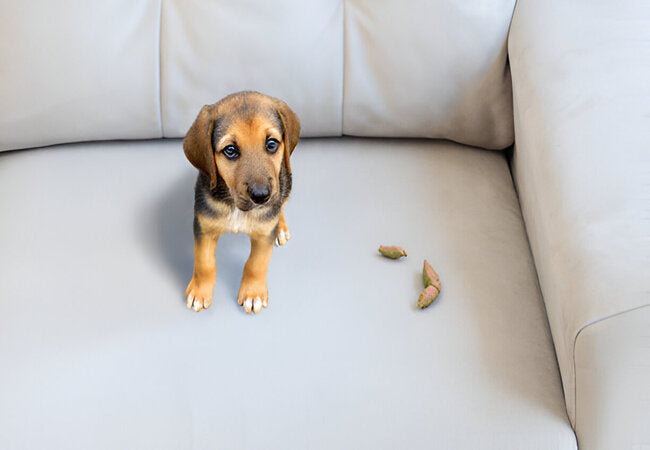2025 Vet Guide: Why Is My Dog Pooping in the House? Solutions & Support 🐶💩

In this article
2025 Vet Guide: Why Is My Dog Pooping in the House? Solutions & Support 🐶💩
By Dr. Duncan Houston BVSc
Hi, I’m Dr Duncan Houston BVSc, veterinarian and founder of Ask A Vet. When your furry friend starts pooping indoors, it can be frustrating. But this behavior often signals health concerns, changes in routine, emotional needs, or aging. In this 2025 guide, we'll explore the top causes, vet-approved strategies, and practical prevention techniques to restore cleanliness compassionately and effectively. 🏠❤️
1. Health Causes 💊
1.1 Gastrointestinal Upset
Vomiting, diarrhea, and urgency often lead to accidents. Causes include parasites, infections, or sudden diet changes.
1.2 Anal Gland Issues
Dogs may defecate indoors due to discomfort from impacted glands. Symptoms include scooting and straining.
1.3 Age‑Related Brain Changes
Canine cognitive dysfunction in seniors can cause neglect of house-training norms.
1.4 Medical Conditions
Diabetes, Addison’s, colitis, or neurological conditions may affect bowel control—consult your vet for diagnosis.
2. Behavioral & Emotional Causes 🧠
2.1 Anxiety & Nervousness
Stress from separation, storms, or new environments triggers sudden pooping accidents.
2.2 Marking or Submission
Although less common, some dogs eliminate indoors to mark territory or show submission under stress.
2.3 Incomplete Toilet Training
Missed cues, inconsistent schedules, or past punishment can lead to unreliable house habits, even in adult dogs.
3. Environmental & Routine Disruptions 🌪️
3.1 Schedule Changes
Vacation, new baby, or new house—routine disruptions can puzzle your dog and lead to indoor pooping.
3.2 Infrequent Potty Breaks
Busy schedules, long workdays, or lack of access can force accidents due to holding limits over time.
3.3 Access Issues
Locked doors, closed gates, or inaccessible areas may prevent outdoor elimination.
4. Veterinary Evaluation Protocol 🩺
- Thorough history (timing, frequency, context, changes).
- Physical exam checking abdomen, anal glands, neurological status.
- Fecal tests for parasites.
- Bloodwork to assess chronic disease.
- Imaging or referrals for complex GI or neurological issues.
5. Treatment & Support Strategies
5.1 Health-Based Interventions
- Parasite/antibiotics/prescriptions for GI causes
- Anal gland expression or treatment.
- Senior dog cognitive supplements.
- Special diets for colitis, IBD, diabetes, etc.
5.2 Behavioral & Training Support
- Return to puppy-style toilet schedule with frequent breaks.
- Praise and reward immediately after outdoor elimination.
- Avoid punishment—fosters fear & confusion.
- Use a crate or gated confinement to prevent indoor accidents.
5.3 Routine & Environment Adjustments
- Set a consistent schedule: morning, after meals, and before bed.
- Ensure potty area access—even during absences.
- Use potty pads or outdoor grass patches in transitional periods.
5.4 Calming Tools
For anxious dogs, consider pheromones, calming chews from Purrz, or anxiety wear (Thundershirt). The Ask A Vet app connects you to targeted calming protocols.
5.5 Cognitive & Mobility Tools for Seniors
- Joint supplements from Woopf.
- Behavior trackers for bathroom patterns via an app.
- Indoor access solutions like ramps, non-slip pads, and accessible outdoor spaces.
6. Prevention Plan: Step-by-Step ✅
- Start with vet diagnostics.
- Re-establish a frequent outdoor potty schedule.
- Track each bowel movement and location.
- Confine safely when unsupervised.
- Clean indoor accidents with enzyme cleaners to remove odor.
- Gradually increase off-leash trust zones.
- Reinforce success with praise or a treat.
- Reassess for underlying issues if accidents persist.
7. Sample Daily Management Plan
- Morning: Potty break + breakfast + outdoor playtime.
- Midday: Potty, walk, mental enrichment + supervised indoor time.
- Afternoon/Evening: Potty + dinner + calm space time + bedtime potty.
8. FAQs ❓
- Q: My dog is 5 years old—why start pooping inside now?
- A: Could signal new illness, anxiety, aging changes, or disruptions to access. Vet exam is recommended.
- Q: Can I punish my dog for accidents?
- A: No—this worsens anxiety and disrupts trust. Focus on correcting situations and encouraging outdoor success.
- Q: Will frequent potty breaks help?
- A: Definitely—frequent outdoor elimination and routine are key to building reliability.
9. Ask A Vet App & Tools Support
The Ask A Vet app offers 24/7 vet chat for diagnostics, routine-building, and behavior tracking. It also suggests calming chews, indoor pads, and mobility aids tailored to your dog's needs from Woopf and Purrz.
10. Final Vet Advice 🏁
Accidents inside often reflect health needs, emotional stress, or lifestyle gaps—not misbehavior. By tackling underlying causes, rebuilding routines, and supporting your dog's body and mind, you can reduce indoor pooping. With expert tools and compassionate care from Ask A Vet, you’ll restore harmony at home, together. 🏡🐾






